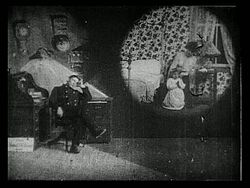| Life of an American Fireman | |
|---|---|
 Opening scene from the film. | |
| Directed by | Edwin S. Porter |
| Starring | Arthur White Vivian Vaughan |
| Distributed by | Edison Manufacturing Company |
Release date |
|
| Country | United States |
| Language | Silent film |
Life of an American Fireman is a short, silent film Edwin S. Porter made for the Edison Manufacturing Company. It was shot late in 1902 and distributed early in 1903. One of the earliest American narrative films, it depicts the rescue of a woman and child from a burning building. It bears notable similarities to the 1901 British short film Fire! , directed by James Williamson.
Contents
In 2016, the film was selected for preservation in the United States National Film Registry by the Library of Congress as being "culturally, historically, or aesthetically significant". [1] [2]